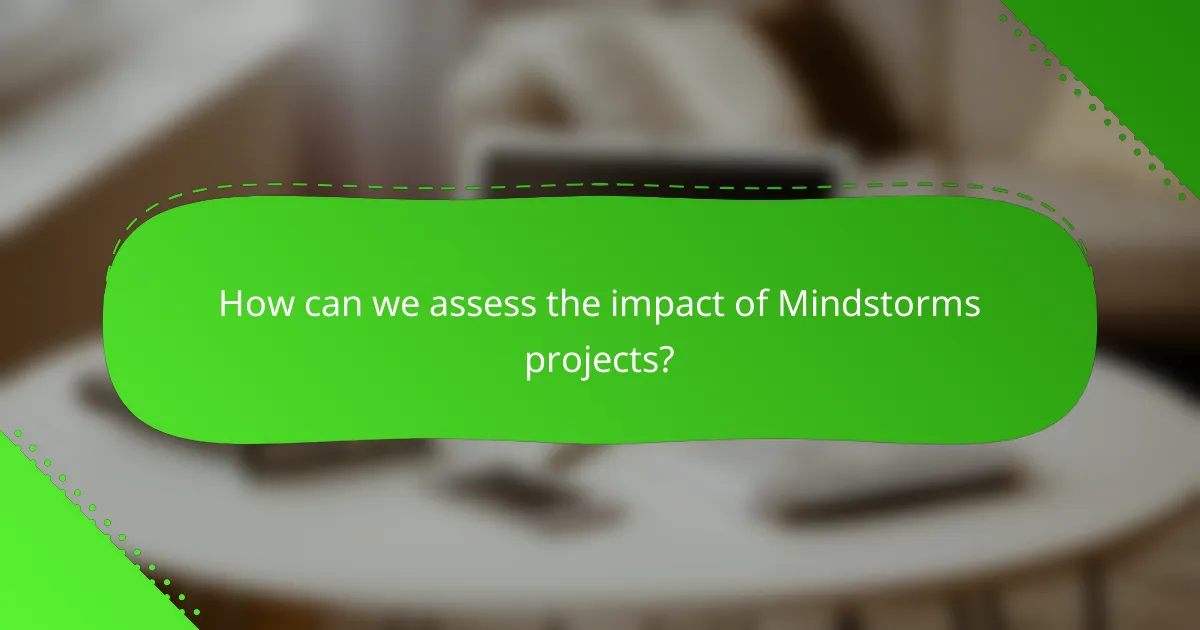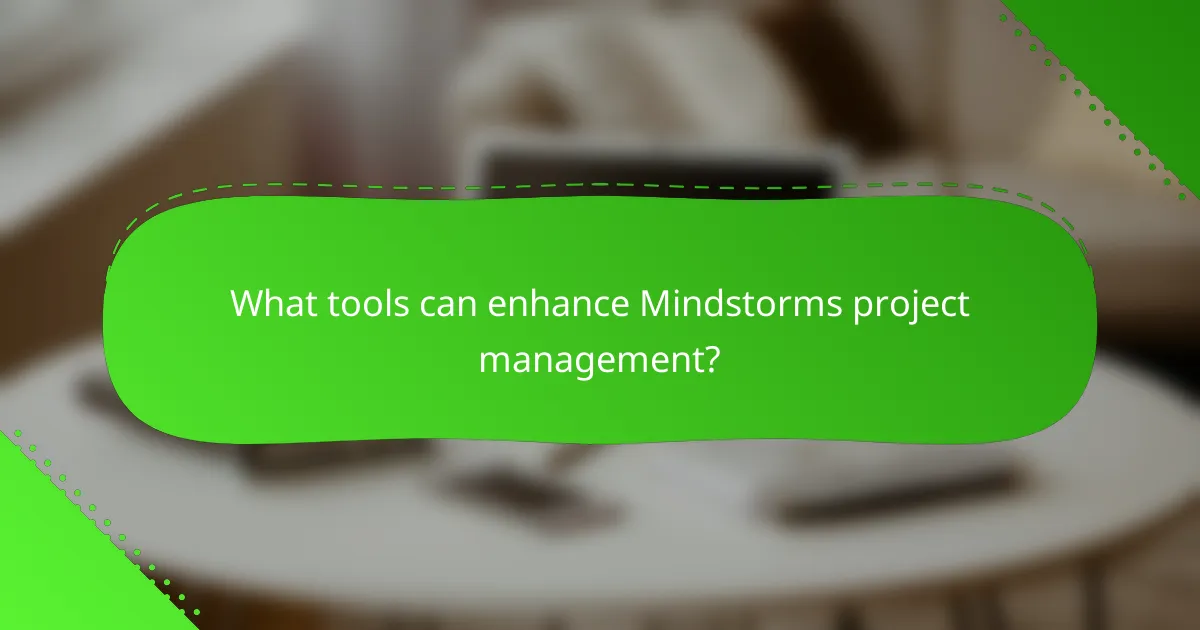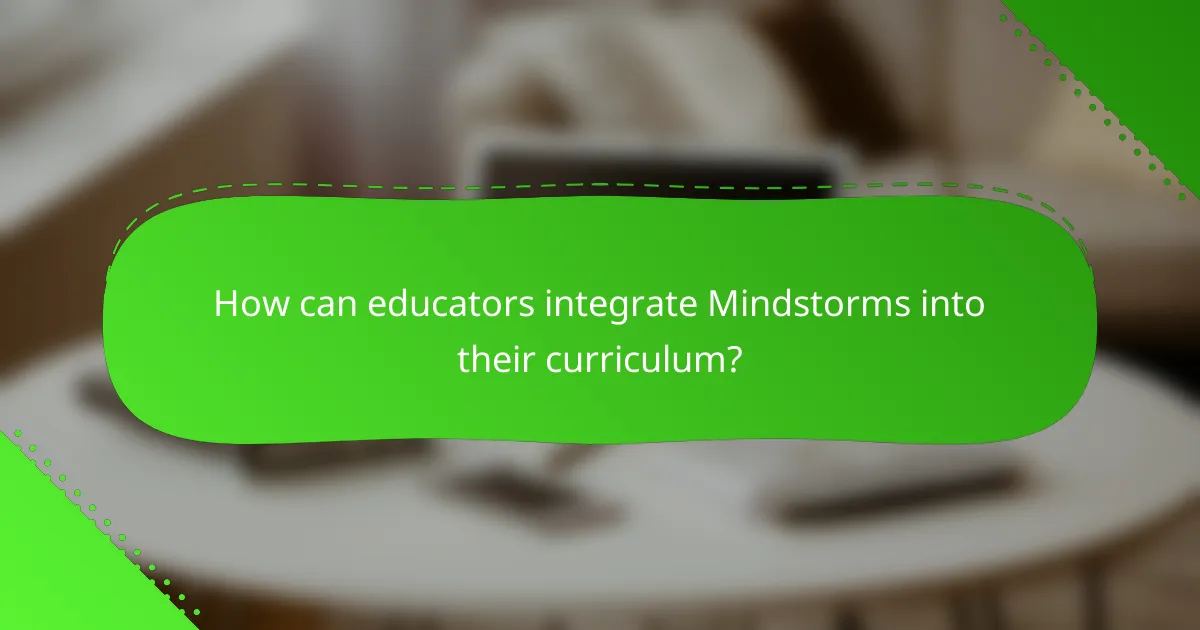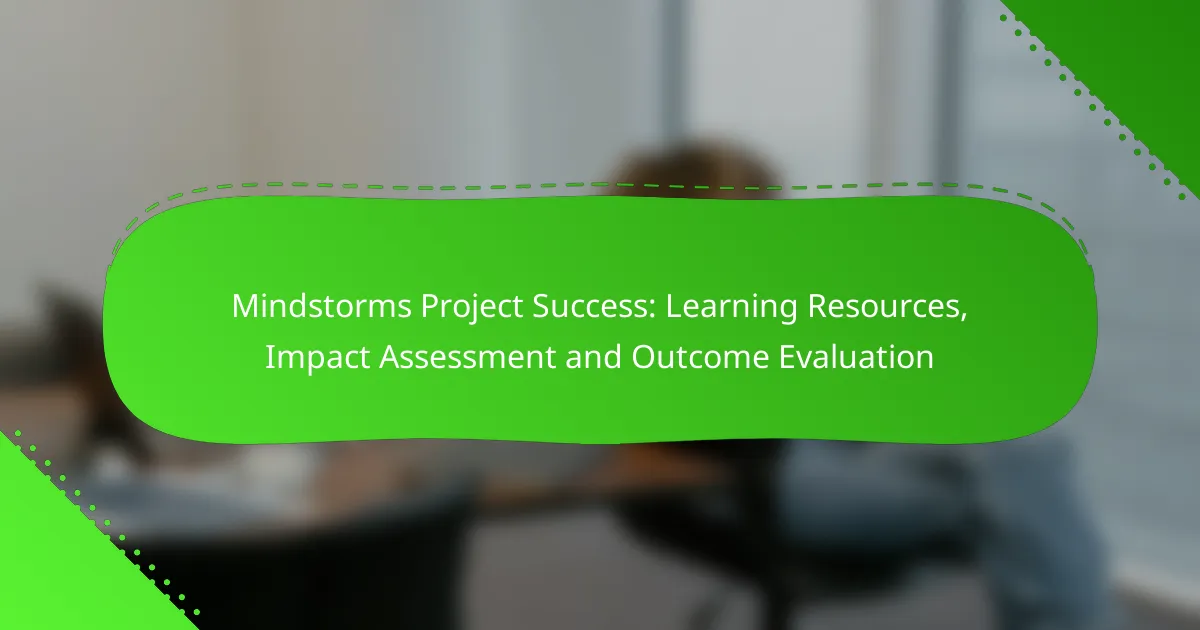The Mindstorms project offers a dynamic approach to learning robotics through effective resources such as structured curricula, online courses, and community engagement platforms. By assessing the impact of these projects, educators can evaluate student engagement and skill development, while outcome evaluations ensure that objectives are met and improvements are identified. This comprehensive framework fosters creativity and enhances programming skills in learners, making robotics accessible and engaging.

What are effective learning resources for Mindstorms projects?
Effective learning resources for Mindstorms projects include structured curricula, online courses, video tutorials, and community engagement platforms. These resources help learners grasp robotics concepts, enhance programming skills, and foster creativity in building and programming LEGO robots.
LEGO Mindstorms Education EV3 Curriculum
The LEGO Mindstorms Education EV3 Curriculum provides a comprehensive framework for educators and students. It includes lesson plans, project guides, and assessment tools designed to facilitate hands-on learning in robotics and programming.
This curriculum is structured around key concepts such as engineering design, programming logic, and teamwork. Educators can adapt the materials to suit different age groups and skill levels, making it versatile for various educational settings.
Online courses on platforms like Coursera
Online courses on platforms like Coursera offer flexible learning opportunities for individuals interested in Mindstorms projects. These courses often cover topics such as robotics fundamentals, programming with EV3, and project management.
Many courses are self-paced, allowing learners to progress according to their schedules. Look for courses that include hands-on projects to apply theoretical knowledge practically, enhancing the learning experience.
YouTube tutorials by robotics experts
YouTube tutorials by robotics experts provide visual and practical guidance for Mindstorms projects. These videos can range from basic programming tutorials to advanced project builds, catering to various skill levels.
When selecting tutorials, consider the creator’s expertise and the clarity of their explanations. Engaging with these resources can help learners troubleshoot common issues and discover innovative techniques for their projects.
Community forums and project showcases
Community forums and project showcases are invaluable for sharing ideas and gaining inspiration for Mindstorms projects. Platforms like LEGO Ideas and robotics forums allow users to post their creations, ask questions, and receive feedback from peers.
Participating in these communities can also lead to collaboration opportunities and access to a wealth of shared knowledge. Engaging with others can enhance motivation and provide new perspectives on problem-solving in robotics.

How can we assess the impact of Mindstorms projects?
Assessing the impact of Mindstorms projects involves evaluating various metrics that reflect student engagement, skill development, and project completion. These assessments help educators understand the effectiveness of the projects and identify areas for improvement.
Student engagement metrics
Student engagement metrics measure how actively students participate in Mindstorms projects. Key indicators include attendance rates, participation in discussions, and time spent on tasks. Tracking these metrics can reveal trends in student interest and motivation.
To effectively assess engagement, consider using surveys or feedback forms to gather student insights. Observational data, such as the frequency of interactions during group work, can also provide valuable information.
Skill development evaluations
Skill development evaluations focus on the specific competencies students gain through Mindstorms projects. This can include technical skills, such as programming and robotics, as well as soft skills like teamwork and problem-solving. Assessments can be conducted through practical tests or project presentations.
Utilize rubrics that outline expected skills and knowledge to provide clear benchmarks for evaluation. Regular check-ins during the project can help identify skill acquisition in real-time, allowing for timely feedback and support.
Project completion rates
Project completion rates indicate the percentage of students who successfully finish their Mindstorms projects. High completion rates suggest effective engagement and skill application, while low rates may highlight obstacles that need addressing. Tracking these rates can help educators refine project structures and support systems.
To improve completion rates, set clear milestones and deadlines throughout the project timeline. Encourage students to set personal goals and celebrate achievements to maintain motivation and focus on project outcomes.

What are the best practices for outcome evaluation in Mindstorms projects?
Effective outcome evaluation in Mindstorms projects involves setting clear objectives, using assessment rubrics, and gathering participant feedback. These practices ensure that the evaluation process is structured, measurable, and reflective of the project’s goals.
Setting clear objectives
Establishing clear objectives is crucial for outcome evaluation in Mindstorms projects. Objectives should be specific, measurable, achievable, relevant, and time-bound (SMART). For example, instead of stating “improve problem-solving skills,” a clearer objective would be “increase students’ ability to solve robotics challenges by 30% within three months.”
When defining objectives, consider the skills and knowledge you want participants to gain. This clarity helps in aligning the evaluation methods with the intended outcomes, making it easier to assess success later on.
Using rubrics for assessment
Rubrics provide a structured framework for assessing participant performance in Mindstorms projects. A well-designed rubric outlines specific criteria and performance levels, allowing for consistent and objective evaluations. For instance, a rubric might assess creativity, technical skills, and teamwork on a scale from 1 to 5.
When creating rubrics, involve stakeholders such as educators and participants to ensure that the criteria reflect the project’s goals. This collaborative approach enhances buy-in and ensures that the assessment is relevant and comprehensive.
Gathering feedback from participants
Collecting feedback from participants is essential for understanding the impact of Mindstorms projects. Surveys, interviews, and focus groups can provide valuable insights into participants’ experiences and perceptions. Aim to gather both qualitative and quantitative data to capture a complete picture.
Consider using anonymous surveys to encourage honest feedback. Questions should focus on aspects such as engagement, learning outcomes, and areas for improvement. Analyzing this feedback can guide future projects and enhance overall effectiveness.

What tools can enhance Mindstorms project management?
Several tools can significantly improve the management of Mindstorms projects by streamlining task tracking, enhancing communication, and facilitating document sharing. Utilizing these tools effectively can lead to better organization and collaboration among team members.
Trello for task tracking
Trello is a visual project management tool that helps teams organize tasks using boards, lists, and cards. Each card can represent a task, allowing team members to assign responsibilities, set due dates, and track progress in real-time.
To maximize Trello’s effectiveness, create boards for different project phases and use labels to categorize tasks by priority or team member. Regularly review and update the boards to ensure everyone stays aligned on project goals and deadlines.
Slack for team communication
Slack is a messaging platform designed for team collaboration, offering channels for specific topics and direct messaging for quick communication. This tool can help Mindstorms teams stay connected, share updates, and resolve issues promptly.
To optimize Slack usage, create dedicated channels for different aspects of the project, such as design, development, and feedback. Encourage team members to use threads for discussions to keep conversations organized and easy to follow.
Google Drive for document sharing
Google Drive is a cloud-based storage solution that allows teams to share and collaborate on documents, spreadsheets, and presentations. This tool is essential for Mindstorms projects, as it enables real-time editing and feedback from multiple team members.
To ensure efficient document management, organize files into folders based on project phases or topics. Set appropriate sharing permissions to control who can view or edit documents, and regularly back up important files to prevent data loss.

What criteria should be considered when selecting Mindstorms resources?
When selecting Mindstorms resources, consider factors such as alignment with educational standards, accessibility for diverse learners, and the overall impact on learning outcomes. These criteria ensure that the resources effectively support educational goals and cater to various student needs.
Alignment with educational standards
Resources should align with local or national educational standards to ensure they meet curriculum requirements. For instance, in the United States, resources may need to adhere to the Next Generation Science Standards (NGSS) or Common Core State Standards. This alignment helps educators integrate Mindstorms projects seamlessly into their teaching plans.
Review the specific learning objectives outlined in your curriculum and choose resources that explicitly address these goals. This may include focusing on STEM skills, problem-solving, and critical thinking. A checklist can help verify alignment:
- Does the resource cover relevant topics?
- Are the learning outcomes measurable?
- Does it support interdisciplinary learning?
Accessibility for diverse learners
Ensuring accessibility for diverse learners is crucial when selecting Mindstorms resources. This includes considering students with different learning styles, disabilities, and language proficiency levels. Resources should be adaptable, allowing for modifications to meet varied needs.
For example, visual aids, step-by-step guides, and multilingual support can enhance understanding for all students. Additionally, consider resources that offer hands-on activities, as these can engage learners who may struggle with traditional instruction. Evaluate resources for inclusivity by asking:
- Are there alternative formats available (e.g., audio, visual)?
- Can the resource be easily modified for different skill levels?
- Does it promote collaboration among students?

How can educators integrate Mindstorms into their curriculum?
Educators can effectively integrate Mindstorms into their curriculum by incorporating hands-on robotics projects that align with learning objectives. This approach not only engages students but also enhances their understanding of STEM concepts through practical application.
Project-based learning approaches
Project-based learning (PBL) with Mindstorms involves students working on real-world problems or projects that require critical thinking and collaboration. Educators can design projects that align with curriculum standards, such as building a robot to solve a specific challenge, which fosters creativity and problem-solving skills.
To implement PBL, educators should start by defining clear learning outcomes and selecting relevant themes. For example, a project could involve designing a robot to navigate a maze, allowing students to apply concepts from physics and engineering while developing programming skills.
Common pitfalls include insufficient planning and lack of resources. Educators should ensure that they have the necessary materials and time allocated for projects, and consider forming partnerships with local businesses or organizations for support. A checklist for successful implementation might include defining project goals, gathering resources, and setting timelines for completion.
